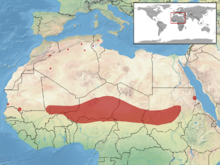Peters's banded skink
| Peters's banded skink | |
|---|---|
| Scientific classification | |
| Domain: | Eukaryota |
| Kingdom: | Animalia |
| Phylum: | Chordata |
| Class: | Reptilia |
| Order: | Squamata |
| Family: | Scincidae |
| Genus: | Scincopus Peters, 1864 |
| Species: | S. fasciatus
|
| Binomial name | |
| Scincopus fasciatus (Peters, 1864)
| |

| |
Peters's banded skink (Scincopus fasciatus) is a skink found in the monotypic genus Scincopus. Peters's banded skink, scientifically known as Scincopus fasciatus, is a species of skink, which is a type of lizard. These skinks are primarily found in the arid and semi-arid regions of Africa, including countries like Namibia, South Africa, and Angola. They are known for their distinctive and attractive appearance.
Key features of Peters's banded skink include:
1. Bands: These skinks have striking black and white bands running along their bodies, giving them their common name. The bands are often quite distinct and can vary in width and intensity.
2. Size: Adults can grow to a size of approximately 15–20 centimetres (6–8 in) in length, with males typically being slightly larger than females.
3. Habitat: Peters's banded skinks are adapted to arid and semi-arid habitats, such as deserts and rocky areas. They are well-suited to these environments and are often found among rocks and in crevices.
4. Behavior: These skinks are primarily ground-dwelling, and they are known for their agility and speed. They are primarily insectivorous, feeding on various small invertebrates, such as insects and arachnids.
5. Reproduction: These skinks lay eggs, with the number of eggs per clutch varying among individuals. The exact reproductive details may vary depending on their specific habitat and environmental conditions.
Peters's banded skinks are popular in the reptile pet trade because of their striking appearance. However, if considering keeping one as a pet, it's essential to research their care requirements and ensure that they are obtained legally and ethically, as the capture and trade of wild-caught animals can be detrimental to their populations. Additionally, it's important to check local regulations regarding keeping reptiles as pets, as they may vary by location.
Captivity
This section may be confusing or unclear to readers. (October 2023) |
Peters's banded skink (Scincopus fasciatus), also known as the Egyptian sandfish or oasis banded skink, is a small, burrowing lizard native to North Africa. If you plan to keep a Peters's banded skink in captivity, it's essential to provide an environment that mimics its natural habitat and meets its specific needs. Here are some guidelines for keeping Peters's banded skinks in captivity:
1. **Enclosure**: Create a suitable enclosure. A glass or plastic terrarium with a secure lid is ideal, as these skinks are excellent at burrowing and can escape easily. The enclosure should be at least 20 gallons in size for one skink, but larger is always better.
2. **Substrate**: Provide a suitable substrate for burrowing. A mix of sand and soil or a specialized reptile substrate can be used. Ensure the substrate is deep enough for them to burrow and create tunnels.
3. **Temperature and Lighting**:
- **Temperature**: Maintain a temperature gradient in the enclosure. The hot side should be around 90-95°F (32-35°C), while the cool side should be around 75-80°F (24-27°C). Use under-tank heating pads or heat lamps to achieve these temperatures. - **Lighting**: Peters's banded skinks are primarily nocturnal, so they don't require UVB lighting. However, providing a 12-hour light/dark cycle can help regulate their internal clocks.
4. **Hide Spots**: Offer plenty of hiding places and shelters, such as rocks, logs, or half-buried objects. These skinks are shy and will appreciate places where they can feel secure.
5. **Humidity**: Maintain a moderately humid environment. Mist the enclosure regularly to keep the substrate slightly damp, but avoid creating a waterlogged environment.
6. **Diet**: Peters's banded skinks are insectivorous, meaning they primarily eat insects. Crickets, mealworms, and small roaches are suitable food items. Provide a varied diet and dust the insects with calcium and vitamin supplements.
7. **Water**: Provide a shallow water dish with fresh water. While these skinks don't often drink from a dish, it can help maintain humidity in the enclosure.
8. **Handling**: Peters's banded skinks are generally shy and may become stressed if handled frequently. It's best to minimize handling and observe them from a distance.
9. **Breeding**: If you plan to breed these skinks, ensure that you have a separate enclosure for the female to lay her eggs, as they are oviparous (lay eggs).
10. **Veterinary Care**: Regularly monitor your skink's health and consult a veterinarian experienced in reptile care if you notice any signs of illness.
Remember that keeping any reptile as a pet comes with a responsibility to provide proper care for its specific needs. Always do thorough research on the species and consult with experts or experienced keepers to ensure you're meeting all of your pet's requirements for health and well-being.
References
- ^ Wilms, T.; Wagner, P.; Niagate, B.; Geniez, P.; Crochet, P.-A.; Mateo, J.A.; Joger, U.; Pleguezuelos, J.; Slimani, T.; El Mouden, E.H.; Baha El Din, S. (2021). "Scincopus fasciatus". IUCN Red List of Threatened Species. 2021: e.T178691A16213861. doi:10.2305/IUCN.UK.2021-1.RLTS.T178691A16213861.en. Retrieved 18 November 2021.

